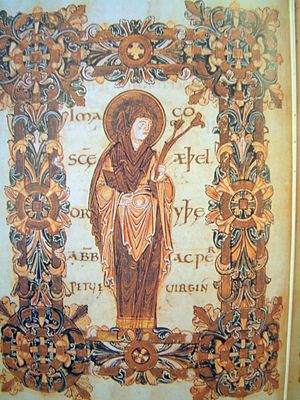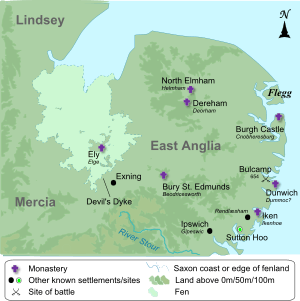Æthelthryth facts for kids
Quick facts for kids SaintÆthelthryth |
|
|---|---|

|
|
| Abbess of Ely | |
| Born | c. 636 Exning, Suffolk |
| Died | 23 June 679 Ely, Cambridgeshire |
| Venerated in | Eastern Orthodox Church Catholic Church Anglican Communion |
| Major shrine | St Etheldreda's Church, Ely Place, Holborn, London; Originally Ely Cathedral (now destroyed) |
| Feast | 23 June |
| Attributes | Abbess holding a model of Ely Cathedral |
| Patronage | Throat complaints |
Æthelthryth (also known as Etheldreda or Audrey) was an important Anglo-Saxon princess, queen, and abbess. She lived from about 636 AD to 679 AD. She is now remembered as a saint in several Christian churches. Her father was King Anna of East Anglia. Her sisters, Wendreda and Seaxburh of Ely, also became abbesses, leading religious communities.
Contents
About Saint Æthelthryth
Early Life and Marriages
Æthelthryth was likely born in Exning, a place near Newmarket in Suffolk. She was one of four daughters of King Anna of East Anglia who became saints. All of them eventually left their royal lives to start religious communities called abbeys.
Around 652, Æthelthryth married Tondberct, a prince of the South Gyrwe people. She had made a special promise to dedicate her life to God before this marriage. Her husband respected this promise. When he died in 655, she moved to the Isle of Ely. She had received this land from Tondberct as a gift.
Becoming a Nun
Later, in 660, Æthelthryth married again for political reasons. Her second husband was Ecgfrith of Northumbria, who was about fourteen or fifteen years old. After he became king in 670, Æthelthryth wanted to become a nun. This wish caused a long disagreement between King Ecgfrith and Wilfrid, who was the bishop of York and Æthelthryth's spiritual advisor.
One story says that King Ecgfrith first agreed that Æthelthryth could remain dedicated to God. But later, he wanted her to fulfill her duties as his wife. Bishop Wilfrid at first convinced the king to let Æthelthryth live peacefully at a nunnery. This nunnery was founded by the king's aunt, Æbbe of Coldingham.
However, Æthelthryth eventually felt she was in danger of being forced to return to the king. So, she fled back to the Isle of Ely with two other nuns. They managed to escape capture, partly because the tide rose and helped them. Another legend says she stopped during her journey and found shelter under an ash tree. This tree supposedly grew from her staff when she planted it in the ground.
In 673, Æthelthryth founded a special kind of monastery at Ely. This was a "double monastery," meaning it had both monks and nuns. Sadly, this monastery was later destroyed in 870 during an invasion by the Danish people.
Her Legacy
The historian Bede wrote about Æthelthryth. He said that after she died, her sister Seaxburh opened her grave. Sixteen years after Æthelthryth's death, her body was found to be perfectly preserved. Her coffin and clothes were also believed to have special powers.
In 695, Seaxburh moved Æthelthryth's remains from a simple grave to the new church at Ely. A white marble sarcophagus (a stone coffin) was found from old Roman ruins. It fit Æthelthryth's body perfectly. Seaxburh made sure her sister's body was cleaned and wrapped in new robes before being reburied.
After Seaxburh, Æthelthryth's niece and great-niece, both princesses, became abbesses of Ely.
Many churches are named after Saint Æthelthryth. St Etheldreda's Church in Ely Place in Holborn, London, is one famous example. It was once part of the palace of the bishops of Ely. After the English Reformation, it was used by Spanish ambassadors, which allowed Catholic worship to continue there.
St Etheldreda's Church, Hatfield is a 13th-century church that was originally Saxon. It was named after Saint Etheldreda because it was next to the palace of the Bishops of Ely, who saw her as their patron saint.
There is also St Etheldreda's in Ely, Cambridgeshire. This is a Catholic church that holds some of Æthelthryth's relics, including her hand.
The common version of Æthelthryth's name was St. Audrey. This name is the origin of the word tawdry. This word came from a yearly fair held in her name in Ely. At this fair, people bought lace goods. By the 17th century, these lace items were seen as old-fashioned or cheap. This is how "tawdry" came to mean something cheap and showy.
Saint Æthelthryth is remembered in the Church of England with a special day on June 23.
See Also
 In Spanish: Eteldreda de Ely para niños
In Spanish: Eteldreda de Ely para niños

- List of Anglo-Saxon saints
- Saint Æthelthryth, patron saint archive
- Wuffingas
- The hymn 'Aethelthryth' by the Venerable Bede
Images for kids
-
Site of shrine in Ely Cathedral



